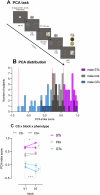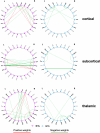Resting-state brain activation patterns and network topology distinguish human sign and goal trackers
- PMID: 39438457
- PMCID: PMC11496639
- DOI: 10.1038/s41398-024-03162-w
Resting-state brain activation patterns and network topology distinguish human sign and goal trackers
Abstract
The "Sign-tracker/Goal-tracker" (ST/GT) is an animal model of individual differences in learning and motivational processes attributable to distinctive conditioned responses to environmental cues. While GT rats value the reward-predictive cue as a mere predictor, ST rats attribute it with incentive salience, engaging in aberrant reward-seeking behaviors that mirror those of impulse control disorders. Given its potential clinical value, the present study aimed to map such model onto humans and investigated resting state functional magnetic resonance imaging correlates of individuals categorized as more disposed to sign-tracking or goal-tracking behavior. To do so, eye-tracking was used during a translationally informed Pavlovian paradigm to classify humans as STs (n = 36) GTs (n = 35) or as Intermediates (n = 33), depending on their eye-gaze towards the reward-predictive cue or the reward location. Using connectivity and network-based approach, measures of resting state functional connectivity and centrality (role of a node as a hub) replicated preclinical findings, suggesting a major involvement of subcortical areas in STs, and dominant cortical involvement in GTs. Overall, the study strengthens the translational value of the ST/GT model, with important implications for the early identification of vulnerable phenotypes for psychopathological conditions such as substance use disorder.
© 2024. The Author(s).
Conflict of interest statement
The authors declare no competing interests.
Figures




References
MeSH terms
LinkOut - more resources
Full Text Sources
Medical
Miscellaneous

